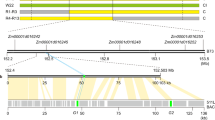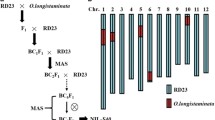Abstract
Cross-incompatibility caused by endosperm abortion was found in advanced generations of backcrossing between the Asian wild (W593) and cultivated (T65wx) rice strains. The near isogenic line, T65WxS 6 (W593), carrying a segment of chromosome 6 from W593 showed a low seed setting when pollinated with pollen grains of T65wx in spite of the fact that the reciprocal cross gave a high seed setting. The unidirectional or asymmetric crossing barrier was previously explained by an interaction between Cif and cim, both of which acted sporophytically, resulting in the cross-incompatibility reactions in the female (CIF) and male (CIM), respectively. In the genetic model, endosperm abortion is induced only when CIF gametes are fertilized with CIM gametes. This predicted that the double homozygote for Cif and cim might be self-incompatible since the plant expresses both CIF and CIM simultaneously. However, we failed to obtain such a self-incompatible plant by transferring Cif into a cim plant. The present results showed that CIF is controlled not only by Cif but also by an additional gene(s) loosely linked with it. We propose here that Cif 1 (formerly named as Cif) and Cif 2 determine CIF. In addition, Cif 2 and Cim were not separated due to restriction of recombination, which might explain why it is difficult to obtain a self-incompatible rice plant expressing both CIF and CIM.



Similar content being viewed by others
References
Amemiya A, Akemine H (1963) Biochemical genetic studies on the root growth inhibiting complementary lethal genes on rice plant. Bull Natl Inst Agric Sci Ser D 10:139–226
Berger F (1999) Endosperm development. Curr Opin Plant Biol 2:28–32
Brink RA, Cooper DC (1947) The endosperm in seed development. Bot Rev 132:423–541
Bushell C, Spielman M, Scott RJ (2003) The basis of natural and artificial postzygotic hybridization barriers in Arabidopsis species. Plant Cell 15:1430–1442
Chu YE, Morishima H, Oka HI (1969) Reproductive barriers distributed in cultivated rice species and their wild relatives. Jpn J Genet 44:207–223
Dung LV, Inukai T, Sano Y (1998) Dissection of a major QTL for photoperiod sensitivity in rice: its association with a gene expressed in an age-dependent manner. Theor Appl Genet 97:714–720
Evans MMS, Kermicle JL (2001) Teosinte crossing barrier1, a locus governing hybridization of teosinte with maize. Theor Appl Genet 103:259–265
Haig D, Westoby M (1991) Genomic imprinting in endosperm: its effect on seed development in crosses between species, and between different ploidies of the same species, and its implications for the evolution of apomixes. Philos Trans R Soc Lond B 333:1–13
Harlan JR, de Wet JMJ (1971) Toward a rational classification of cultivated plants. Taxon 20:509–517
Ichitani K, Namigoshi K, Sato M et al (2007) Fine mapping and allelic dosage effect of Hwc1, a complementary hybrid weakness gene in rice. Theor Appl Genet 114:1407–1415
Johnston SA, den Nijs TPM, Peloquin SJ et al (1980) The significance of genic balance to endosperm development in interspecific crosses. Theor Appl Genet 57:5–9
Kermicle JL (2006) A selfish gene governing pollen-pistil compatibility confers reproductive isolation between maize relatives. Genetics 172:499–506
Kermicle JL, Alleman M (1990) Gametic imprinting in maize in relation to the angiosperm life cycle. Development Suppl 9–14
Kermicle JL, Allen JO (1990) Cross-incompatibility between maize and teosinte. Maydica 35:399–408
Lin BY (1984) Ploidy barrier to endosperm development in maize. Genetics 107:103–115
Macnair MR (1989) The potential for rapid speciation in plants. Genome 31:203–210
Matsubara K, Khin-Thidar , Sano Y (2003) A gene block causing cross-incompatibility hidden in wild and cultivated rice. Genetics 165:343–352
Murray MG, Thompson WF (1980) Rapid isolation of high molecular weight plant DNA. Nucleic Acids Res 8:4321–4325
Nelson OE (1993) The gametophyte factors of maize. In: Freeling M, Walbot V (eds) The Maize Handbooki. Springer-Verlag, New York, pp 496–503
Nishiyama I, Yabuno T (1979) Triple fusion of the primary endosperm nucleus, a cause of interspecific cross-incompatibility in Avena. Euphytica 28:57–65
Oka HI (1957) Phylogenetic differentiation of cultivated rice. XV. Complementary lethal genes in rice. Jpn J Genet 32:83–87
Oka HI (1974) Analysis of genes controlling F1 sterility in rice by the use of isogenic lines. Genetics 77:521–534
Rashid A, Paterson PA (1992) The RSS system of unidirectional cross-incompatibility in maize: I. Genet J Hered 83:130–134
Sano Y (1992) Genetic comparisons of chromosome 6 between wild and cultivated rice. Jpn J Breed 42:561–572
Scott RJ, Spielman M, Bailey J et al (1998) Parent-of-origin effects on seed development in Arabidopsis thaliana. Development 125:3329–3341
Sitch LA, Dalmacio RD, Romero GO (1989) Crossability of wild Oryza species and their potential use for improvement of cultivated rice (Oryza sativa L.). Rice Genet Newsl 6:58–60
Snape JW, Bennett MD, Simpson E (1980) Post-pollination events in crosses of hexaploid wheat with tetraploid Hordeum bulbosum. Z Pflanzenzüchtg 85:200–204
Stebbins GL (1958) The inviability, weakenss and sterility of interspecific hybrids. Adv Genet 9:147–215
Suzuki R, Sawamura N, Okazawa T et al (2003) Genetic basis of F1 hybrid sterility and gamete formation in rice. In: Kush GS, Brar DS, Hardy B (eds) Advances in rice genetics. Supplement to rice genetics IV. Los Baños, Philippines
Tiffin P, Olson MS, Moyle LC (2001) Asymmetrical crossing barriers in angiosperms. Proc R Soc Lond B Biol Sci 268:861–867
Acknowledgments
We thank Drs A. Kanazawa, Y. Kishima, K. Onishi for their suggestion, and Miss N. Sawamura and Mr R. Suzuki for assistance. This work was supported in part by grants from the Ministry of Education, Science and Culture and the Ministry of Agriculture, Forestry and Fisheries of Japan (Integrated research project for plant, insect and animal using genome technology GD-2001).
Author information
Authors and Affiliations
Corresponding author
Rights and permissions
About this article
Cite this article
Koide, Y., Ikenaga, M., Shinya, Y. et al. Two loosely linked genes controlling the female specificity for cross-incompatibility in rice. Euphytica 164, 753–760 (2008). https://doi.org/10.1007/s10681-008-9707-4
Received:
Accepted:
Published:
Issue Date:
DOI: https://doi.org/10.1007/s10681-008-9707-4




